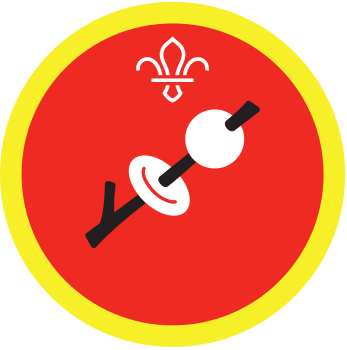
Campfire sausage rolls
You’ll need
- Hot embers and coals
- Dutch oven (or equivalent fireproof casserole dish with lids)
- Campfire grill or equivalent
- Bucket of sand and/or water
- PPE (protective equipment) such as heatproof gloves
- First aid kit for burns
- Ingredients (see recipe card)
- Mixing bowls
- Heatproof tongs
- Sharp knives
- Baking sheet
- Greaseproof paper
- Fork (to whisk egg)
- Pastry brush or similar (to add egg wash)
- Plates
Before you begin
- Use the safety checklist to help you plan and risk assess your activity. There's also more guidance to help you carry out your risk assessment, including examples. Don’t forget to make sure all young people and adults involved in the activity know how to take part safely.
- Make sure you’ll have enough adult helpers. You may need some parents and carers to help if you’re short on helpers
- You could run our kitchen safety and hygiene activities, Kitchen risk bingo and Home kitchen hygiene prior to running this session.
- Remember to have a hand washing station and take extra hygiene precautions when handling food. Take a look at our guidance on food preparation.
- Make sure you have all the ingredients ready.
- You may want to run a fire safety talk or show people how to use the equipment safely, such as for cooking or chopping ingredients.
- Remember to check for allergies, eating problems or dietary requirements and adjust the recipe as needed. Make sure you've checked everyone's dietary requirements and allergies then adapted the recipe as appropriate. This may include ensuring no cross-contamination during food preparation, too.
- Check if there are any items of food (or packaging) that people can’t touch or be near to or if there are items that people might not be comfortable using in the activity.
- Some people may not like certain food textures or tastes and that’s OK. Try to find an alternative for them. No-one has to use all the ingredients or be made to try foods if they’re not happy, comfortable or don’t want to.
- This recipe is designed to be cooked in a Dutch Oven on top of hot coals.
- Build and light a fire before starting this activity. Our activities, Campfire admirers or Construct a campfire, can help you to do this. You’ll use the hot embers to cook on, so the fire will need enough time to die down before cooking.
- You could run our fire safety activities, Fuel, air, ignition! and Sitting safely by a campfire, prior to running this session.
- Remember to have a hand washing station and take extra hygiene precautions when handling raw meat, such as regular hand washing, having separate equipment for raw and cooked meat, and washing up equipment as soon as it's been used. Take a look at our guidance on food preparation.
- Make sure you have all the ingredients ready. To prepare your ingredients, you’ll need chopping boards, knives, a garlic press or alternative, and a cheese grater.
- Remember to check your ingredients against any allergy or dietary requirements to ensure everyone can enjoy the recipe. This may mean using alternative ingredients.
- Once the fire has burned to hot embers and coals, it is hot enough for you to cook your dish on.
- Remember to have protective equipment to move the Dutch Oven, such as heatproof gloves, available. The entire surface area of the Dutch Oven will be extremely hot.
- Make sure that everyone’s fires have been built outdoors in clear, open areas, with plenty of ventilation, and away from any areas where people will be sleeping.
- All the fires need to burn down to hot embers before they can start cooking. This increases the chance of the fuel burning without enough oxygen present, increasing the risk of carbon monoxide exposure. We have more guidance on different cooking methods.
- If using a gas stove, make sure it’s on a stable heatproof surface and in a clear and open area, with plenty of ventilation.
Getting ready to cook
- Gather everyone together in a circle and tell them you’re going to make campfire sausage rolls.
- You may want to run a fire safety talk or show people how to use the equipment safely, such as for cooking on a campfire or chopping ingredients.
- Ask everyone to wash their hands before cooking, then collect the ingredients. People can get into groups or pairs, as needed.
Make your sausage rolls
Ingredients
- 1-2 sheets of puff pastry
- 4 sausages
- 200g bacon lardons or plant-based alternative
- 2 cloves garlic, minced
- 1 brown onion, small, finely chopped
- 1 egg
- Cheese (optional)
- Herbs (optional)
Prep time: 5-15 minutes
Cook time: 20-30 minutes
Makes: 6 small sausage rolls or 2 large sausage rolls.
- Everyone should wash their hands, if they haven’t already.
- Peel the skin off the sausages, then add them to a bowl.
- Finely chop the onion and garlic, then add the onion and bacon into the bowl. You may want to add in some herbs, such as rosemary, thyme or sage.
- Mix the ingredients together thoroughly.
- Take a sheet of puff pastry and carefully lay it out on a baking sheet.
- Put the mixture on one end the puff pastry sheet width ways, so it goes from one edge to the other.
- If you’ve additional mixture, you could use an additional sheet of puff pastry to make some more sausage rolls.
- When ready, roll the mixture up in the puff pastry, making sure it overlaps at the bottom and all the mixture is enclosed in the pastry.
- Someone should crack an egg in a small bowl and whisk it quickly.
- When whisked, spread some egg on the end on the pastry sheet edge to join it to the pastry roll. Then, spread a thin egg wash across the whole sausage roll.
- You may want to add some cheese on top of the sausage roll, too.
- Cut the sausage roll to size, such as into 2 or 6.
- Take a cold Dutch oven and place greaseproof paper inside the oven.
- Place the sausage rolls into the cold Dutch oven.
- Using heatproof gloves and tongues, and with adult help, carefully place your Dutch Oven on your campfire grill. Make sure it’s above your campfire embers, so it’s getting indirect heat.
- Let the sausage rolls cook for around 20-30 minutes, until cooked through and golden brown.
- An adult should carefully remove your Dutch Oven from the heat, remembering to wear the heatproof gloves. They should place it down on a heatproof surface in a safe place, away from young people, and allow it to cool.
- Once cooled, carefully take your sausage rolls out of your Dutch oven using utensils and put them on a plate. Divide them up into bowls or onto plates for your group to try. Enjoy!
Reflection
A campfire isn’t just for cooking. People have always made fires to ward off predators, keep us warm, illuminate an area and attract attention. Now that we have electric and gas stoves that we can take on camp, why might we still need a campfire?
Is it just the fun of sharing something with the rest of the group? Is it the social aspect of having somewhere communal to sit with your fellow campers?
How did it feel working in groups? Did people take on different roles? How did you go about combining your skills to complete the tasks?
Everyone needed to be responsible and safe around the fire. There are lots of risks and hazards that we must be mindful of when enjoying our fire and using it for cooking. Can anyone spot the different ways we have tried to keep everyone safe?
Safety
All activities must be safely managed. You must complete a thorough risk assessment and take appropriate steps to reduce risk. Use the safety checklist to help you plan and risk assess your activity. Always get approval for the activity, and have suitable supervision and an InTouch process.
- Sharp objects
Teach young people how to use sharp objects safely. Supervise them appropriately throughout. Store all sharp objects securely, out of the reach of young people.
- Flammable items
Always take care when using flammable items, especially if you’re near fire. Always follow the manufacturer’s instructions and guidelines.
- Hot items and hot water
Kettles, cookers and microwave ovens produce a lot of heat by the very nature of them. Caution is needed when in contact with items that have been heated and young people should use them under adult supervision. Use on a suitable surface, protecting it if necessary. Never leave hot items unattended and make sure there’s a nearby first aid kit, with items to treat burns/scalds.
- Food
Remember to check for allergies, eating problems, fasting or dietary requirements and adjust the recipe as needed. Make sure you’ve suitable areas for storing and preparing food and avoid cross contamination of different foods. Take a look at our guidance on food safety and hygiene.
- Fires and stoves
Make sure anyone using fires and stoves is doing so safely. Check that the equipment and area are suitable and have plenty of ventilation. Follow the gas safety guidance. Have a safe way to extinguish the fire in an emergency.
- Cooking
Teach young people how to use cooking equipment safely. Supervise them appropriately throughout. Make sure it’s safe to use and follow manufacturers’ guidelines for use.
- Outdoor activities
You must have permission to use the location. Always check the weather forecast, and inform parents and carers of any change in venue.
- Remember to check your ingredients against any allergy or dietary requirements to make sure everyone can enjoy the recipe.
- There are lots of different jobs that need doing when planning, making and cooking on a campfire. There’s a role for everyone, so encourage everyone to be involved in a way that works for them.
- If anyone needs help or struggles with fine motor skills, such as when chopping, give them the opportunity to work in pairs, with a young leader or an adult volunteer.
All Scout activities should be inclusive and accessible.
Consider running this activity as part of a lunch or dinner on camp that’s cooked over a campfire. We’ve lots more recipes to inspire you, too.
This recipe is very adaptable. Young people can choose what special flavours they want to add to their sausage rolls, you could try some caramelised onion ones or add some chilly jam to add a sweet spicy flavour.



